
Hydrosaurus, commonly known as the sailfin dragons or sailfin lizards, is a genus in the family Agamidae. These relatively large lizards are named after the sail-like structure on their tails. They are native to Indonesia and the Philippines where they are generally found near water, such as rivers and mangrove. Sailfin lizards are semiaquatic and able to run short distances across water using both their feet and tail for support, similar to the basilisks. They are threatened by both habitat loss and overcollection for the wild animal trade.

The sailfin molly is a species of fish in the genus Poecilia. As with the other types of mollies, P. latipinna is a livebearer, giving birth to free-swimming babies, a trait they share with similar fish species such as guppies, platies and swordtails. Sailfin mollies typically inhabit both freshwater and brackish waterways along the East Coast of the United States, from North Carolina south to Florida, and around the Gulf of Mexico to Texas, and south to the Yucatán Peninsula of México. Given their preference for more brackish water conditions, mollies are often found within just a few yards or miles of the ocean, inhabiting coastal estuaries, lagoons, river deltas and swamps, as well as tidal areas with a regular inflow of oceanic minerals and nutrients mixing with inland freshwater sources.

The Philippine sailfin lizard, also known as crested lizard, sail-fin lizard, sailfin water lizard, soa-soa water lizard or its native name ibid, is an oviparous lizard found in several of the islands that make up the Philippines, in New Guinea, and some parts of eastern Indonesia. The Philippine Sailfin Lizard is a protected species in its native country of the Philippines as it is a target for exotic pet collectors and sought after in the international pet trade. This is largely because these lizards have unique dorsal crests that give the organism a structure similar to a sail, and the Philippine sailfin lizard also has very bright coloration patterns that make them attractive to the eye. The pustulatus species is unique within the Hydrosaurus genus because of the confusion for the past several decades of classifying these organisms amongst other lizards within their same genus in their habitat. They are also very talented swimmers, and smaller juvenile lizards can run on top of water due to their bodily structure. The genus Hydrosaurus means water lizard, which reflects the aforementioned abilities lizards have in water. The Philippine sailfin lizard usually lies close to bodies of water, stays in tree branches, and runs across the ground to get around their habitat. They utilize their sailfins/scales to do territorial displays in the presence of a competitor or a predator. In terms of their reproduction, they utilize sexual reproduction and breed one time each year, but they can produce multiple clutches of eggs with between 2 and 8 eggs. These eggs are buried into the soil for a period of two months before hatchlings are produced. Philippine sailfin lizards are heavily studied by herpetologists and other scientists, as they are unique amongst other reptile lizards with regard to their coloration and form.
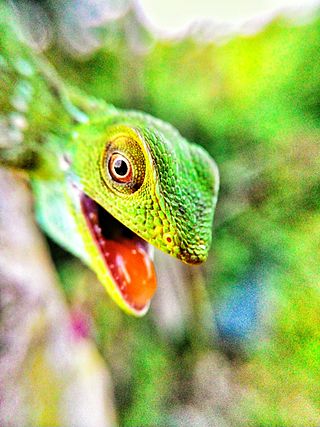
Bronchocela jubata, commonly known as the maned forest lizard, is a species of agamid lizard found mainly in Indonesia on the islands of Singkep, Java, Bali, Sulawesi, Karakelang, Salibabu; Nias Island, Singkap Island, Borneo (Kalimantan) also in Thailand, Cambodia and Philippines. Although in the past it was thought the species may be found in India, either on the mainland or in the Nicobars, this is not the case according to herpetologist Das. It is also known by the common name of "bloodsucker", although this is a misnomer.

Calotes calotes, the common green forest lizard, is an agamid lizard found in the forests of the Western Ghats and the Shevaroy Hills in India, and Sri Lanka.

The Caucasian agama is a species of agamid lizard found in the Caucasus, E/S Georgia, Armenia, Azerbaijan, Turkmenistan, Tajikistan, Dagestan (Russia), E Turkey, Iraq, N Iran, Afghanistan, NW Pakistan, and parts of Kashmir.

The Himalayan agama is an agamid lizard found in Central Asia and South Asia.

Laudakia tuberculata is a species of agamid lizard found in northern Pakistan, northern India, Nepal, eastern Afghanistan, and western China.

The peninsular rock agama or South Indian rock agama is a common species of agama found on rocky hills in south India. An allied species, Psammophilus blanfordanus, is found in the Eastern Ghats, but north of the range of this species.
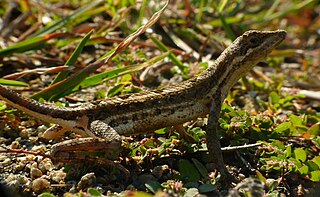
The Pondichéry fan-throated lizard is a species of agamid lizard found in eastern peninsular India. It was earlier thought to be widespread but studies in 2016 resulted in the splitting of the group into several species placed in two genera. The genus Sitana has an enlarged projecting scale on the posterior side of the hind thigh which is absent in the sister genus Sarada.
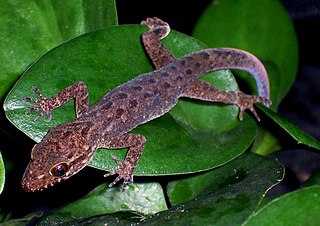
The marbled bow-fingered gecko is a species of gecko found in Southeast Asia.

The Moluccan sail-finned lizard or Ambon sailfin dragon is a large agamid lizard native to moluccas or Maluku Islands in Indonesia, growing to about one metre (3.3 ft) in length. It is often confused for being the largest of the sailfin dragons; however, that title belongs to Hydrosaurus microlophus, with the second largest of the sailfin dragons being Hydrosaurus celebensis.

The Celebes warty pig, also called Sulawesi warty pig or Sulawesi pig, is a species in the pig genus (Sus) that lives on Sulawesi in Indonesia. It survives in most habitats and can live in altitudes of up to 2,500 m (8,000 ft). It has been domesticated and introduced to a number of other islands in Indonesia.
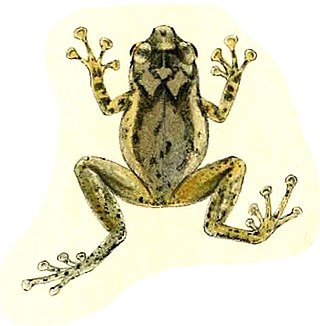
Oreophryne celebensis is a species of frog in the family Microhylidae. It is endemic to northern Sulawesi, Indonesia. Common name Celebes cross frog has been coined for it.

The Virgin Islands dwarf sphaero, Virgin Gorda least gecko, or Virgin Islands dwarf gecko is a species of gecko and also one of the smallest terrestrial vertebrates. It has only been found on three of the British Virgin Islands: Virgin Gorda, Tortola, and Moskito Island. It was discovered in 1964 and is suspected to be a close relative of Sphaerodactylus nicholsi, a dwarf sphaero from the nearby island of Puerto Rico. It shares its range with the big-scaled least gecko (S. macrolepis), which is found in leaf litter. Unlike this larger gecko, the Virgin Islands dwarf sphaero lives on drier hillsides, yet prefers moist microhabitats found under rocks because it lacks the adaptations necessary for preventing water loss, which is a significant problem due to its small body size.

Weber's sailfin lizard or Halmahera sailfin dragon, is a species of lizard in the family Agamidae. The species is endemic to Indonesia.
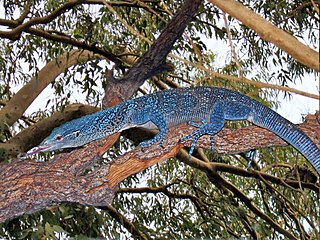
Varanus macraei, the blue-spotted tree monitor or blue tree monitor, is a species of monitor lizard found on the island of Batanta in Indonesia. It is named after herpetologist Duncan R. MacRae, founder of the reptile park Rimba on Bali.
The gibber earless dragon also known as the smooth-snouted earless dragon, is a species of agamid lizard endemic to Australia. It is one of a documented species of the genus Tympanocryptis, a group of small terrestrial lizards that feed off invertebrates and are characterised by the absence of an external ear structure.

The Indonesian giant sailfin dragon is a species of agamid native to south sulawesi Indonesia. It is the heaviest and longest species of sailfin lizard, making it the largest of all the Agamidae. It is often mistaken for its counterpart because of the incorrect information of Hydrosaurus Amboinensis being the largest of the sailfin dragons.
There are two species of lizard named Sulawesi sailfin lizard, both native to Indonesia:


















